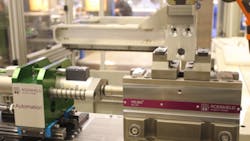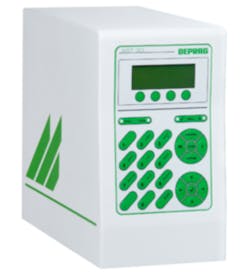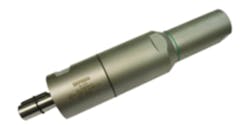Automated Clamping Pays Off, Even for Small Batches
Robotic automation is increasingly common in the production of high-value and high-quality workpieces. But, such set-ups require a clamping device to hold a component in place, ready for machining. However, when using a conventional palette storage system the machining steps can be carried out only in a fully automated process. Then, production flow is held up if components need to be turned, or if clamping jaws (or even entire fixtures) need to be changed. Roemheld, a specialty developer of clamping systems (and other automation machinery) has an alternative.
Roemheld technicians and design engineers develop customer-specific solutions, and their new clamping development involved some collaboration with Deprag Schulz GmbH — which also develops automation concepts, involving screwdriving technology and air motors, as well as more complex automation programs.
At EMO 2013, Guido Born, Roemheld’s product manager for the Workpiece Clamping System product line,described some new solutions for automated machining, solutions that can be implemented sustainably even for very small of batches of production.
Q: Over the past 20 years international machine tools usage has risen by 70%. Half of all such machines come from Europe alone and are supplied to more than 70 countries. These figures indicate an opportunity for suppliers of production technology, but in the global competition who really is ahead?
The theme of EMO 2013 was “Intelligence in Production,” so it required intelligent solutions for production technology that are sustainable into the future, so that they can cope with the enormous pressures on costs and the ever-increasing demands for efficiency and environmental sustainability. I think that we in Europe have a certain leadership role to play here in all of these aspects, and that we are ahead of the global competition.
What does that mean for your particular product area, clamping technology?
Born:We are constantly striving to reduce clamping and set-up times for our customers in the machining of their workpieces. Shorter clamping and set-up times, longer machine runtimes, greater accuracy of workpiece machining and precise repeatability of every clamping force and positioning routine are the most significant advantages of this automation solution and they were a clear focus of our design work.
What effect do the new clamping systems have?
Born:Every step of the process - from inserting the workpiece into the clamping device, the machining process and removing the workpiece is automated. If workpieces need to be turned during machining, and the clamping jaws require changing, or the clamping area altered, these processes can also be automated. It means that several clampings and different work processes can be carried out without manual intervention.
To what sort of workpieces are the new automation solutions suited?
Born:Our clamping solutions are suitable for components of varying sizes, dimensions and geometries, enabling machining on up to six sides with no operator intervention. Of course the restrictions on dimensions and mass are imposed by the available machine space and the type of freely selected robot used.
Spindles Drive Clamping
To develop the automated mechanical clamping elements you worked with Deprag, According to Peter Gnüchtel (of Deprag Schulz GmbH), that series includes a selection of EC-Servo screwdriver system and pneumatic screwdrivers, for which spindles are the drive that opens and closes the relevant clamping fixture.
Born:But screwdriver systems from Deprag offer much more than this … comprehensive expertise in control technology, and that is what makes this collaborative venture so valuable for us.
Can you go into a bit more detail?
Besides a hydraulic solution we also now supply a pneumatic and fully automatic version. These new variants are based on standard Deprag components. A 280W Deprag Advanced Line air motor drives the pneumatic clamping fixture. With it the operator can use both hands to insert a heavy workpiece into the clamping element, while pressing a foot pedal to start the air motor to set the spindle in motion to clamp the component. But for the fully automated solution we opted for Deprag EC screwdriving systems.
Gnüchtel: The screwdriving process control system sets the required speed and revolution rate. There is no need to fiddle around with a torque wrench. The result is a repeatable and steady frictional connection to ensure the high quality of the machining processes, such as machine cutting or polishing. It is easy to control the function directly on the device.
Retrofitting Options
The automation module is also suitable for retrofitting existing clamping systems. Is that not an expensive operation?
Gnüchtel: Absolutely not. With the compact modular structure of our screwdriver units, they can be incorporated into any machine.
Born:The Deprag screwdriving function module with its straightforward interfaces considerably reduced the work involved in system integration for our customer. We received the screwdriving module from Deprag as a ready-to-integrate functional component that had been specifically and comprehensively tested on our sample parts.
Gnüchtel: Another of the priority aims of our design engineers is to minimize servicing and maintenance costs. That way, the integral standard software is able to connect quickly, easily and cost-effectively with the basic LC156 control system selected for the self-centering systems, with 30 inputs and 26 outputs. The menu navigation is already fully available within the standard program: communications TP-CPU, error handling, limit switch monitoring, touch panel (TP) menu, error output, oils, parts counter and cycle time, sliding tables, manual operating functions.
The automated HILMA MC self-centering clamping system is suited ...
Born:… particularly well for workpieces on vertical and five-axis machining centers. On the other hand the dual-spindle module, which Deprag developed in collaboration with our company, is used on our TS 125 range of tower clamping systems. This now also enables us to automate secure, multiple clampings with low set-up times on horizontal machining centers. Our HILMA TS tower clamping systems are the universally deployed base element for a wide variety of positioning and clamping tasks in a flexible manufacturing environment.
Trixy Schmidt, a technology reporter and editor, interviewed Roemheld’s Workpiece Clamping Systems product manager Guido Born, and Deprag Schulz applications specialist Peter Gnüchtel.



